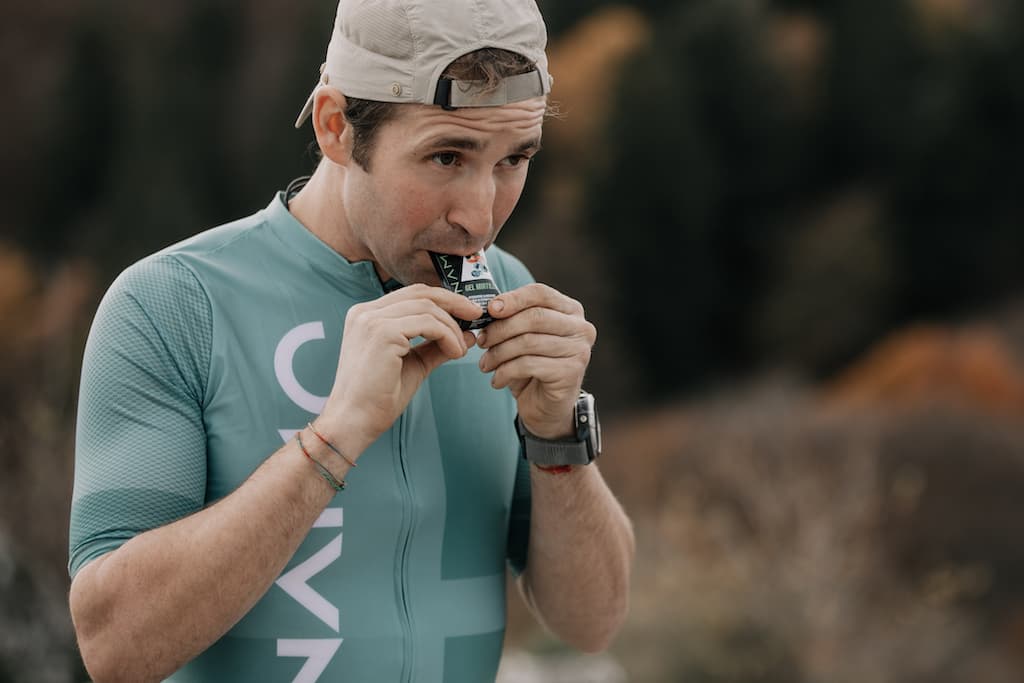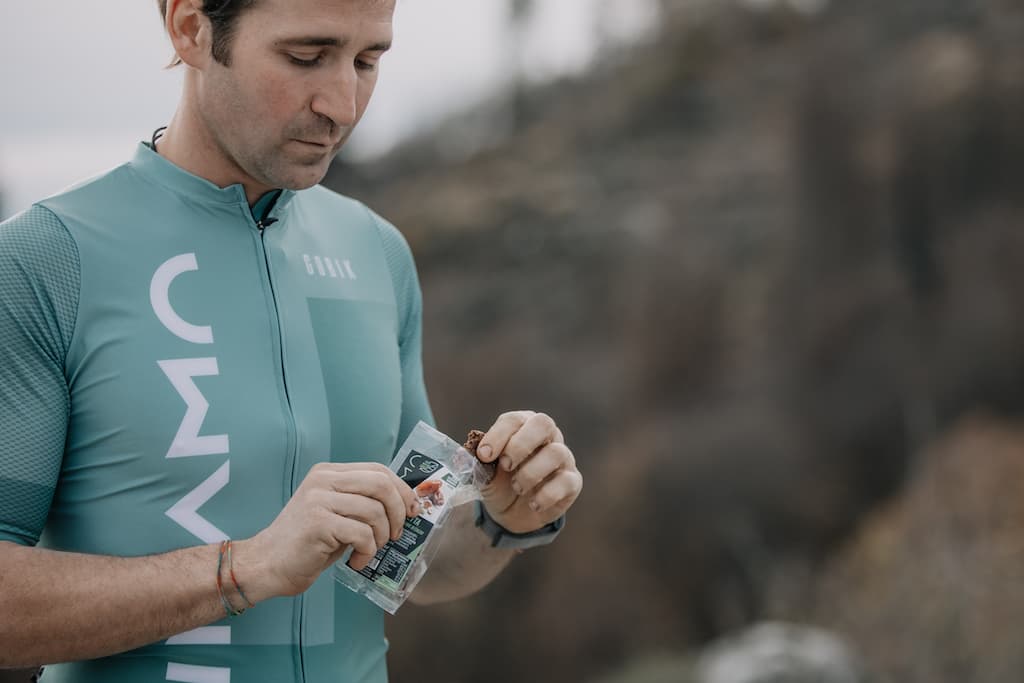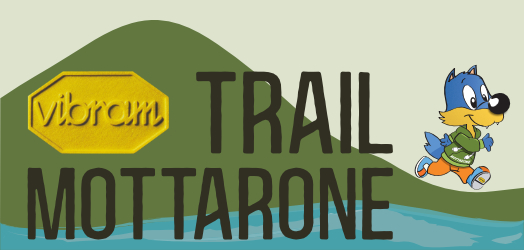The outcome of an endurance race is influenced by both the level of training and the quality of nutrition.
It is therefore essential to feed yourself adequately in the days leading up to and during the race: the longer the running time, the more our body will be put to the test, as energy needs will become more and more exasperated.
When the distance exceeds one hour, the body uses more energy than it can store, so it is imperative to eat and drink properly to limit drops in performance.
The ability to maintain performance even after several hours of racing makes the difference between winning, losing and simply arriving without the need for ambulance support.
Joking aside, the success of an endurance race is linked to proper supplementation and nutrition during it.
For example, if the first hour of the race is done by pushing, energy consumption, and therefore the need to replenish, varies significantly (both in terms of quantity and quality) compared to a gentle pace.
Let's take a look at how best to prepare for an endurance race lasting more than two hours, bearing in mind that preparation begins at least two days beforehand and requires taking care of several elements, including rest.

Endurance race: advice in the two days beforehand.
In this phase, the aim is to fully recharge glycogen reserves: around 350-400g is the maximum stowage between liver and muscle. Therefore, in the 2 days before the race, I recommend basmati rice and wholegrain cereals for lunch and dinner, in quantities not exceeding 100g (raw weight) and always accompanied by lean proteins, such as chicken or turkey breast, egg-white fritters, fish. It is therefore better to go for foods with a medium glycemic index (between 55 and 70), because those with a high glycemic index (such as refined cereals, sweets and simple sugars) increase the production of insulin, the hormone that tends to convert sugars into fat and increase inflammation.
This avoids the risk of arriving at the race very bloated and weighed down and feeling less than optimal.
On race day.
Preparing for the race is not only about calories, but also about water.
A dehydrated organism in fact works on saving: in the race, on the other hand, we must give our all... and more.
It is necessary to drink adequately, up to an hour before the event, in order to present oneself at the start in an ideal state of hydration.

At the start and during the race.
It is essential to know the route, the altimetry, the refreshments, the points of maximum energy expenditure, the stretches where you can slow down your pace… in order to nourish yourself adequately and avoid drops in performance.
The objective is to do everything possible to allow our body and mind (yes, even the mind) to express themselves to the full and allow us to enjoy, despite the inevitable fatigue, being in nature.
It takes a minimum of strategy and organization based on knowledge.
In general, you should drink at least 600 ml of fluid per hour during the race, up to a maximum of 1 liter per hour in the most difficult conditions.
It is essential to supplement the 4 salts: magnesium and potassium, chlorine and sodium, especially for efforts of this kind.
It should be known that in intense and prolonged efforts, more than 100g of sugar per hour may be needed, but the body saturates its glucose assimilation channels as early as 60g per hour.
However, it is possible to improve sugar assimilation by adding maltose and fructose, a key concept for long and very long efforts, say over 3 hours.
Having said this, let's take the altimetry of the race to structure a plan for minimum supplementation and nutrition during the course:

Start - Mottarone (4 gels, 2 carbo bars, 1 sandwich/rice cake, 4 almonds, mineral salts)
The first climb is steep and requires a significant effort: in addition to taking a few sips of water when possible, it is certainly necessary to ingest a first gel and a second one taken after 30-35 minutes from the start, which will allow us to arrive at the first Monte Camoscio water refreshment point where I recommend sipping water with mineral salts, filling the water bottle and eating a carbo bar (which should in any case be consumed no later than 40-45 minutes after the second gel): this will take us to the first peak of 1006 metres of altitude reached after almost 6 km of the race.
Once there, take 1 gel and climb.
Now begins a small descent of 130m of elevation gain over 1km of track before the second climb of 600m of elevation gain over 4.3km of track: you definitely need a gel after about 35-40 minutes from the previous one to arrive, without dropping, at the Alpe Nuovo water refreshment point where I recommend, in addition to filling your water bottle, eating a carbo bar while continuing to move in the direction of the next water/solid refreshment point on Mottarone.
We are at the highest point of the route: I recommend eating a small sandwich (30-40g) with jam (or a rice cake) and 3-4 almonds.
Mottarone - Coiromonte (1 gel, 1 carbo bar, 1 small sandwich/rice cake, 4 almonds, mineral salts)
During the descent to the next water refreshment point at Coiromonte: after 40-45 minutes from the sandwich/rice cake, continuing to sip water whenever possible, consume a carbo bar and, after a further 40-45 minutes, a further gel that will take us to the refreshment point where we will eat a small sandwich (30-40g) with jam (or a rice cake) and 3-4 almonds, drinking water and salts
It is essential to maintain a regular cadence in the introduction of normal food during such long races: we must avoid feeding ourselves only with gels and bars, which could upset the palate and stomach. In addition, we must also provide the body with a greater variety of macronutrients, including protein (albeit in a very small part).
Finally, we must prevent the stomach from 'shutting down' and thus not allowing us to continue feeding ourselves and sustaining our performance.
Coiromonte - Gignese (1 carbo bar, 1 sandwich/rice cake, 4 almonds, mineral salts)
Through the stretch leading to the next water refreshment point in Gignese: after 40-45 minutes from the sandwich/rice cake, continuing to sip water alternating with salts, consume a further sandwich/rice cake and 4 almonds and then, about 40 minutes later, a carbo bar with which we will reach the water refreshment point in Gignese, beyond the 30th km of the race.
Gignese - Stazione Borromea (1 sandwich/rice cake, 4 almonds, mineral salts)
After 40 minutes from the carbo bar, consume a sandwich/rice cake and 4 almonds, continuing to sip water alternating with salts to tackle the last climbs of the route and reach Stazione Borromea.
Stazione Borromea – Someraro – arrival (1 gel, 1 carbo bar, 4 almonds, mineral salts)
We are now in the last 10 km of the race. If you have nourished yourself adequately, you will be in a condition where you have not depleted muscle protein to support your energy expenditure, and you will feel in control of your body, with no problems of cramping.
Before leaving for the final descent, I recommend taking 1 carbo bar and 4 almonds at the refreshment stop at Stazione Borromea, followed after about 40 minutes (presumably near the last water refreshment stop at Someraro) by 1 gel.
On arrival, finally, eat to recover.
In this respect, post-race recovery must be based first of all on carbohydrate replenishment, in order to take advantage of the anabolic window of glycogen, which allows rapid recovery in the first hours after exertion: generous doses (up to 150g) of basmati rice and fresh fruit will make an excellent contribution to starting the recovery processes.

Total minimum supplementation: 6 gels, 5 carbo bars, 4 small rice sandwiches/cakes, 20 almonds, mineral salts
A tip on preparing small sandwiches (30-40g) for the race.
In addition to jam, you can fill the sandwiches with honey and a pinch of table salt, or with honey and parmesan shavings.
This improves the integration of salts and gives a taste variable to the palate which, in such a demanding race, should be reset by alternating sweet (or very sweet as in the case of gels) and salty tastes.
Dott. Alessandro Bonetti
